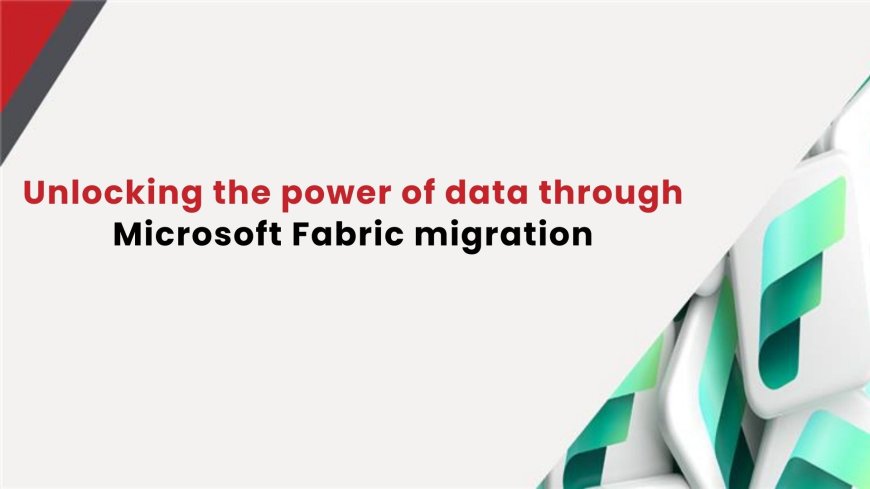Unlocking the power of data through Microsoft Fabric migration
Microsoft Fabric is a unified data platform that consolidates data and analytics tools and eliminates complexities in extracting actionable insights from your scattered business data.

Microsoft Fabric is a unified data platform that consolidates data and analytics tools and eliminates complexities in extracting actionable insights from your scattered business data. Whether it is data engineering, data analytics, data ingestion, or storage – Fabric brings everything under one roof. What about enterprises using individual tools for their data processes? Should they migrate to Fabric? Yes, most enterprises have already started their migration to Microsoft Fabric as it empowers their data ecosystem, unlocking better insights and efficiency. In this blog, we will discuss Microsoft Azure Synapse migration to Fabric scenario.
Let’s start by understanding what Microsoft Fabric is and why it is important.
An integrated data analytics platform that integrates various data tools such as Azure Data Factory, Synapse Analytics, Data Lake, Power BI, and more into one data environment. Here are some advantages of migrating to Microsoft Fabric
-
Unified Data Experience: Consolidate different workloads and organize your workflows in one platform.
-
Scalability: Empowers enterprises with scalability to scale up or down instantly without many efforts based on business requirements.
-
Advanced Analytics: More advanced AI and ML features and tools to leverage for better insights.
-
Cost Optimization: Helps simplify the management and licensing processes, leading to the optimization of the associated costs.
Here are some components of Fabric that we need to understand:
Storage Layer:
OneLake, known as the storage layer in Microsoft Fabric, stores all workloads and stages. It is auto-provisioned to store data coming from various sources. Moreover, the auto-indexing feature enables enterprises to easily discover compliance and governance data. All tabular format data is stored in a common data format.
Compute Layer:
Compute engines like Spark, KQL, and SQL save their data in OneLake automatically because there is no import required for compute engines to access OneLake.
Access Control:
Based on the user’s permissions, membership is defined in four categories: Viewer, Contributor, Member, and admin.
Factors to keep in mind while migrating
There are plenty of factors that contribute to a healthy migration to Fabric, but here we have highlighted some of the most important factors that one should consider:
-
Assess your existing data infrastructure – whether it is hybrid, on-premise, or cloud architecture.
-
Set your business goals related to what needs to be achieved with the migration, such as better performance, scalability, and/or cost optimization.
-
During the migration process, enterprises consider data governance and security to be important factors in keeping the data secure.
-
Check if there are gaps in your teams’ expertise and skill sets. You need to plan to train them with Microsoft Fabric platform features and capabilities.
Before we start our migrations process of Azure Synapse Spark to Fabric, we need to ensure that Fabric Data Engineering is the best available solution for all the data workflow; it supports notebook, Spark job definitions, data pipelines, lakehouse, and other different Spark capabilities.
Once you finalize Fabric Data Engineering as the choice for the migration process of your existing Azure Spark workloads, there could be various phases and scenarios of migration:
Items: This scenario involves transferring one or multiple items or workloads from Azure Synapse to Fabric.
Data and pipelines: Using OneLake shortcuts, you can build ADLS Gen2 data, which is available in Fabric Lakehouse. As its name suggests, it involves moving your pipelines to Fabric, including Spark job definition and notebook pipeline actions.
Metadata: In this scenario, enterprises move Spark catalog Metadata, which includes partitions, tables, and datasets, from Hive MetaStore to Fabric Lakehouse.
Workspace: You need to first create a new workspace in Microsoft Fabric and then migrate your existing Azure Synapse Workspace there, including Metadata.
Here are some common challenges that enterprises face during any migration process:
-
Migrating data sets from multiple tools and sources could be a daunting task. Having the right Microsoft Fabric consulting agency by your side can solve this challenge.
-
Sometimes, users resist change because they are already accustomed to legacy systems. Sharing the benefits of Fabric and helping them with proper training can solve this challenge of change management.
-
Sometimes migrating to entire workspace and live systems leads to downtime. However, an expert Microsoft fabric consultant can help you with phased approach processes to reduce downtime and disruptions.
-
Without proper monitoring, migration costs can go out of control. There are tools available in Fabric to help you monitor and optimize resource usage.
Conclusion:
Microsoft Fabric is a unified analytics platform that caters to all your analytics requirements. Enterprises can boost their analysis processes and deliver exceptional business results by migrating their existing workloads to Microsoft Fabric. However, thorough planning is required before implementing the migration process. Here comes the importance of a certified Microsoft Fabric consulting service provider like Saxon AI. Migrating to Fabric could be a complex task, but not if you are connected with the experts. Let’s get started on your journey.
What's Your Reaction?


























